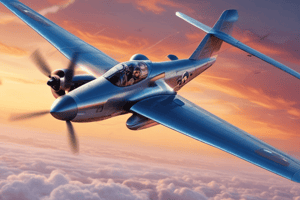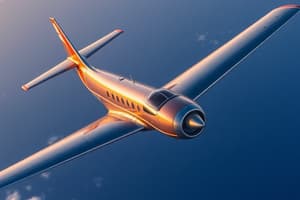Podcast
Questions and Answers
What force makes an airplane turn?
What force makes an airplane turn?
The horizontal component of lift
If an airplane weighs 2,300 pounds, what weight would the airplane structure need to support during a 60° banked turn while maintaining altitude?
If an airplane weighs 2,300 pounds, what weight would the airplane structure need to support during a 60° banked turn while maintaining altitude?
4,600 lbs
How does frost affect the lifting surfaces of an airplane on takeoff?
How does frost affect the lifting surfaces of an airplane on takeoff?
- Increases lift
- Causes the airplane to become airborne at lower speeds
- Reduces drag
- Prevents the airplane from becoming airborne at normal takeoff speed (correct)
Around which axis does the elevator control movement in an aircraft?
Around which axis does the elevator control movement in an aircraft?
What must a pilot be aware of as a result of ground effect?
What must a pilot be aware of as a result of ground effect?
What happens if frost is not removed from the wings before takeoff?
What happens if frost is not removed from the wings before takeoff?
Why do pilots use wing flaps during flight?
Why do pilots use wing flaps during flight?
What is the relationship of lift, drag, thrust, and weight during straight-and-level flight?
What is the relationship of lift, drag, thrust, and weight during straight-and-level flight?
Flashcards are hidden until you start studying
Study Notes
Airplane Turn
- The horizontal component of lift is the force that makes an airplane turn.
- When the wings of an airplane are not level, the lift is not entirely vertical and tends to pull the airplane toward the direction of the lower wing.
- The pilot coordinates rudder, aileron, and elevator to bank in order to attain a horizontal component of lift.
Lift and Airfoil
- Air traveling faster over the curved upper surface of an airfoil causes lower pressure on the top surface.
- Bernoulli's principle states that the internal pressure of a liquid or gas decreases at points where the speed of the fluid increases.
Banked Turn and Load Factor
- During a 60° banked turn, the load factor is 2, which means the airplane structure is required to support twice the weight of the airplane.
- For example, a 2,300-lb airplane would require its wings to support 4,600 lb during a 60° banked turn.
Angle of Attack
- The angle between the relative wind and the wing chord line is the angle of attack.
- The wing chord line is a straight line from the leading edge to the trailing edge of the wing.
Stall and Load Factor
- A positive load factor of 2 at 80 mph would cause the airplane to stall.
- The Velocity vs. G-loads chart indicates that operating at a load factor of 2 and an airspeed of 80 mph would result in a stalled condition.
Ground Effect
- During takeoff, an airplane leaving ground effect will experience an increase in induced drag and a decrease in performance.
- An increase in angle of attack is required to maintain the same lift coefficient, and the airplane will experience a decrease in stability and a nose-up change in moment.
Control Surfaces
- The effectiveness of control surfaces increases with airspeed.
- As airspeed increases, the pilot will notice an increase in control effectiveness, especially during takeoff in a crosswind.
Flaps
- One of the main functions of flaps during approach and landing is to increase the angle of descent without increasing the airspeed.
- Extending the flaps increases the wing camber and the angle of attack of the wing, which enables the pilot to increase the angle of descent without increasing the airspeed.
Center of Pressure
- Changes in the center of pressure of a wing affect the aircraft's aerodynamic balance and controllability.
- The center of pressure (CP) is the point at which all of the upward lift forces on the wing are concentrated.
Frost and Takeoff
- Frost on the wings of an airplane can prevent the airplane from becoming airborne at normal takeoff speed.
- Frost disrupts the airflow over the wing, increasing drag and making it difficult to get the airplane airborne at normal takeoff speed.
Elevator Control
- The elevator controls movement around the lateral axis of the aircraft.
- The elevator is the primary control device for changing the pitch attitude of an airplane.
Ground Effect and Flare
- Ground effect reduces the upwash, downwash, and vortices caused by the wings, resulting in a decrease in induced drag.
- Any excess speed at the point of flare may cause considerable floating.
Wing Flaps and Approach
- Pilots use wing flaps during flight to enable steeper approaches to a landing without increasing the airspeed.
- Extending the flaps increases the wing camber and the angle of attack of the wing, which enables the pilot to make steeper approaches to a landing without increasing the airspeed.
Preflight Inspection and Frost
- Frost on the wings of an airplane can disrupt the smooth flow of air over the wing, adversely affecting its lifting capability.
- Frost can decrease the lift by about 30%, even with a light coat of frost.
Straight-and-Level Flight
- In straight-and-level flight, lift equals weight and thrust equals drag.
- All forces meet and are equal in the center of gravity (CG), typically at the center of the cockpit.
Studying That Suits You
Use AI to generate personalized quizzes and flashcards to suit your learning preferences.




